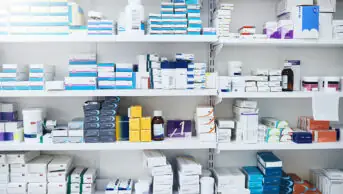
Shutterstock.com
More than half of acute trusts in England failed to reduce their antibiotic use between 2017/2018 and 2018/2019, according to figures analysed by The Pharmaceutical Journal, with some trusts having increased their antibiotic consumption by as much as 27% in the same year.
In 2018/2019, antibiotic consumption in acute trusts in England ranged from 1,782.1 defined daily doses (DDDs) of antibiotics dispensed to all inpatients and outpatients per 1,000 admissions, to 9,217.1 DDDs of antibiotics dispensed per 1,000 admissions, according to figures collated by
The Pharmaceutical Journal from Public Health England’s (PHE’s) ‘Fingertips’ database.
DDDs is a statistical measure of drug consumption used to standardise comparisons between different drugs or healthcare settings.
NHS trusts are incentivised to reduce antibiotic consumption through the Commissioning for Quality and Innovation framework (CQUIN), which was introduced in 2009 to make a proportion of healthcare providers’ income conditional on demonstrating quality improvements.
To receive payment under CQUIN in 2018/2019, trusts had to achieve a 1% reduction in total antibiotic consumption that year; if they had achieved the target 2% reduction the previous year, or a 2% reduction if they had failed to reach the 2017/2018 target.
However, only 47.1% of acute trusts achieved a reduction of 1% or more in 2018/2019, while 39.4% achieved a reduction of 2% of more.
In the same year, more than half of the acute trusts either achieved no reduction in this measure or saw an increase in the number of DDDs of antibiotics dispensed to all inpatients and outpatients per 1,000 admissions. Increases ranged from 0.2% to 26.6%.
Netta Tyler, antimicrobial pharmacist at Royal Papworth Hospital NHS Foundation Trust, which saw a 23.4% increase, explained that, as a centre specialising in the management of complex respiratory infections, use of antibiotics at Papworth was higher than many other hospitals.
“A significant proportion of our antibiotic use is in the outpatient setting, which helps to minimise hospital admissions and provides benefits for patients and the wider health economy,” she said.
But she added that the hospital had been working to reduce its antibiotic usage.
“Preliminary data from Q2 2019/2020 suggests a 20% reduction in usage compared to the peak in Q3 2018/2019,” she said.
One trust that did achieve a drop in antibiotic use was Birmingham Women’s and Children’s NHS Foundation Trust, which saw a 22.6% reduction in DDDs of antibiotics dispensed to all inpatients and outpatients per 1,000 admissions between 2017/2018 and 2018/2019.
“We’re trying to change [our] culture to thinking about antibiotics as a precious resource as opposed to a safety blanket,” said Alison Tennant, chief pharmacist at the trust.
She explained that the reduction achieved by the hospital was the outcome of a range of factors; including the merger between Birmingham Women’s Hospital and Birmingham Children’s Hospital in 2016, which saw a change in the mix of antibiotics being consumed and shortages of antibiotics in recent years.
But the “critical success factors”, she said, were a result of the size of the trust and because, unusually, the trust’s antimicrobial resistance programme had a strong consultant leadership, making it “easier to get a consistent message out”.
A PHE report published on 31 October 2019 estimated that, in 2018, patients in England contracted 165 antibiotic-resistant infections per day.
The report by the English surveillance programme for antimicrobial utilisation and resistance , published in November 2019, also revealed that antibiotic use had increased in secondary care by 2.8% in the past five years.


